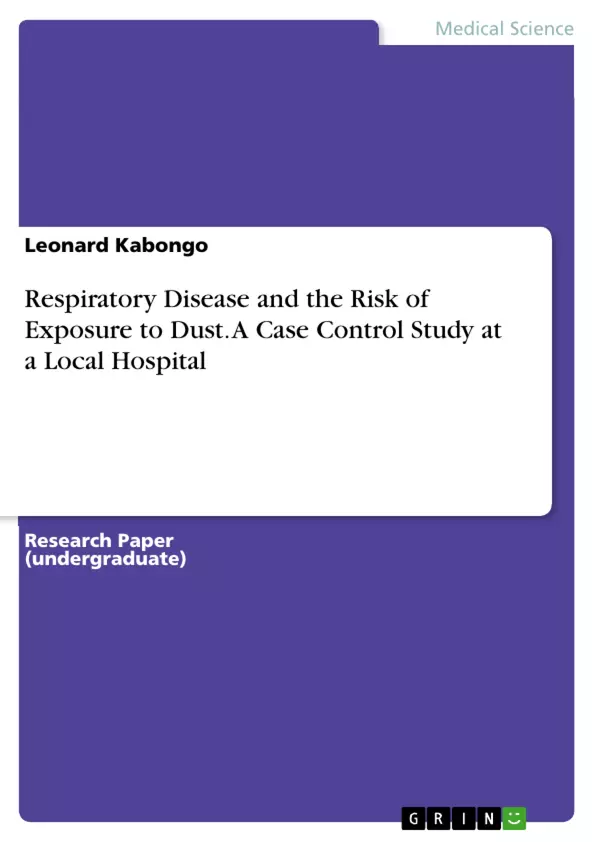At a local Hospital, an increased number of people admitted and treated for Respiratory Disease have been observed and most of them work at a local Factory. There is a concern that the dust generated by the machinery at the Company would be the contributing factor.
A Case Control Study will be conducted on the Incidence of respiratory disease to prove or disapprove the association between the incident cases of respiratory disease and the exposure to the dust generated by the factory.
The Research Protocol is adapted from the World Health Organization proposed study protocol format (WHO, 2014).
The protocol will state the problem and the hypothesis generated to be tested, the aim and objectives to be achieved and the current knowledge on the topic in a literature review.
A thorough explanation on the choice of the study design, methodology and sampling will be preceded by the study outcome and its measurement methods.
Data collection and analysis using statistical methods with the potential sources of bias are elaborated. A discussion highlighting the pros and cons of this study as well as the study limitations are explained.
A conclusive summary and Ethic statements followed by a list of References will shape the end of this study.
Inhaltsverzeichnis (Table of Contents)
- Introduction
- Problem Statement and Hypothesis
- Aims of the study
- Objectives
- Literature Review
- Study design and Methodology
- Sampling
- Potential Sources of bias and management
- Data collection and Analysis
- Discussion
- Study limitations
- Conclusion
Zielsetzung und Themenschwerpunkte (Objectives and Key Themes)
This research protocol aims to investigate the potential association between exposure to factory-generated dust and the occurrence of respiratory disease at a local hospital. The study will use a case-control design to determine the relative risk of respiratory disease among factory workers compared to other groups. This protocol is adapted from the World Health Organization's proposed study protocol format.
- The relationship between factory-generated dust exposure and respiratory disease.
- The relative risk of respiratory disease among factory workers compared to other groups.
- The influence of confounding factors such as age, gender, smoking status, length of exposure, and co-morbidity on respiratory disease development.
- The development of targeted interventions to reduce the burden of respiratory disease among factory workers and the general population.
- The potential for dust control measures to reduce respiratory disease in industrial settings.
Zusammenfassung der Kapitel (Chapter Summaries)
- Introduction: This chapter introduces the study, outlining the observed increase in respiratory disease cases at a local hospital, particularly among factory workers. It highlights the concern regarding factory dust as a potential contributing factor and details the methodology of the case-control study.
- Problem Statement and Hypothesis: This chapter presents the study's central question: Is there an association between exposure to factory-generated dust and the occurrence of respiratory disease? It establishes the null hypothesis (no association) and the alternative hypothesis (exposure is associated with disease). This section also explores the role of variables like age, gender, length of exposure, smoking status, and co-morbidity.
- Aims of the study: This chapter outlines the primary and secondary aims of the study. The primary aim is to determine whether there is evidence to support the hypothesis that exposure to factory-generated dust is associated with respiratory disease. The secondary aim is to investigate the effects of other confounding factors on respiratory disease development.
- Objectives: This chapter highlights the study's objective to develop targeted interventions for reducing the burden of respiratory disease among factory workers and the general population by understanding the distribution of respiratory disease within these groups.
- Literature Review: This chapter reviews existing research on the impact of dust exposure in various industries, including cement plants, mining, agriculture, and wood industry. It explores the mechanisms by which dust can cause respiratory problems and highlights the potential for both minor and major respiratory tract diseases. The chapter also cites studies demonstrating the association between occupational exposure to dust and specific respiratory conditions like allergic rhinitis, asthma, and COPD.
Schlüsselwörter (Keywords)
The primary keywords and focus topics of this research protocol include respiratory disease, factory dust exposure, case-control study, relative risk, confounding factors, dust control measures, and targeted interventions. The study aims to provide evidence-based insights into the relationship between industrial dust exposure and respiratory health.
- Citar trabajo
- Dr Leonard Kabongo (Autor), 2015, Respiratory Disease and the Risk of Exposure to Dust. A Case Control Study at a Local Hospital, Múnich, GRIN Verlag, https://www.grin.com/document/305671



